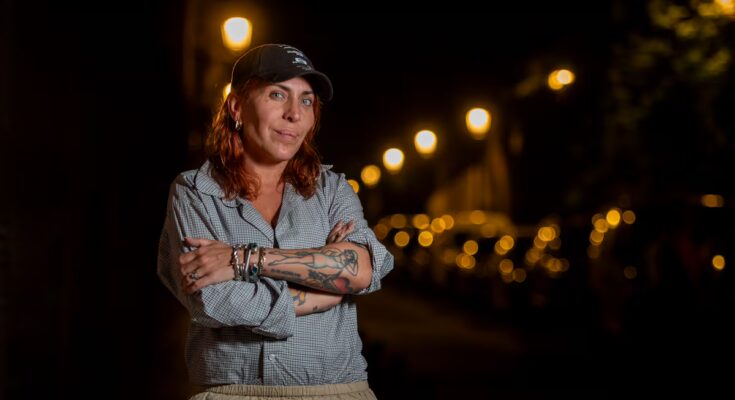Alba Melendo’s life takes place between Paris, Milan and Madrid among fabrics and pop stars, at a faster pace than the clang of the sewing machines with which haute couture garments are adapted to the bodies of her clients. This 39-year-old from Madrid, born in Teruel, but raised in Puerta de Toledo (Madrid), is on the lips of the biggest stars of current music and they all want to work with her. Karol G, Aitana and Bad Gyal rely on her and her team of nine assistants to dress them and their dancers. Even great sports figures, such as Alexia Putellas. Furthermore, designers like Palomo Spagna entrust their fashion shows to Melendo so that nothing goes wrong. And in the meantime he records Fashion sucks, together with the journalist Raquel Fernández Sobrín, a podcasts about fashion that reveals the details of the industry, breaks clichés and presents Spanish professionals who are successful in the world. Last October 21st they premiered the second season with even more powerful names and an office where listeners can ask them whatever they want.
Ask. What does a stylist do?
Answer. In Spain it is someone who takes care of the make-up and hair, but outside of the term it refers to those of us who build a person’s image through their clothes, whether it is a photo shoot, a concert, a video clip, a public appearance…
Q. It looks fun and professional.
R. AND. I couldn’t stand an office job. My favorite thing is to dress a pop superstar and then to tiktoker with 40 million followers and from there to a gold-winning Olympic gymnast. How nice to share a moment of my life with those women. The excuse is the dress, but interesting conversations, new friendships arise…
Q. How do you get there?
R. I studied journalism, through my parents, but I always wanted to dedicate myself to fashion. The degree gave me a broad vision of the world and I entered fashion there, as a reporter in Milan for Fashion TV, an international channel that no longer exists. Then I created the magazine ODDA and I taught myself to manage everything, from photos to advertising.
Q. Do you have to overcome many obstacles?
R. This is background work. This profession used to be for people with money, but not anymore. For me it was fundamental to live abroad, to enter the center of fashion in Paris and Milan. In Spain, for example, it is normal for makeup and hair to be done by the same person. That outside is unthinkable.
Q. Is it difficult to satisfy a superstar?
R. It all depends on sensation. I have to believe in your project. I started with celebrities for an economic reason, because magazines don’t make money anymore. But it’s one of my favorite jobs. I learn as I go. Until I started with Karol G I had not done a tour, nor had I dressed 300 dancers for the Latin Grammys or for the NFL (the American football league) in Brazil. I love working with Aitana, who is a lot of fun and who I can ride with it seems iconic at the level of Britney Spears. Although there are some drawbacks: dressing celebrities takes away your credibility in the fashion world. The most exclusive companies stop seeing you as someone belonging to the elite.
Q. How does it affect you?
R. I try to be present everywhere and leave nothing aside, neither the catwalks nor the magazines.
Q. How do you integrate it into your projects?
R. I can decide myself or work side by side with the artist’s creative director, as with Karol G, who coordinates with his Pablo Artola.
Q. She likes to dress them not only with new things, but also with historical pieces from the designer.
R. Luxury is no longer wearing new things, but, precisely, wearing iconic garments by great designers of the past. I like to browse through shops and archives to find the clothes that I saw in magazines as a child and that I have fixed in my memory. Although I tell you that I also buy from Cobo Calleja (the largest Chinese merchandise store in Madrid), because they have unbranded accessories that are used to create it seems, especially for advertising.
Q. In the fashion world not much has been said about Gaza…
R. Fashion is a business with people with many cross-interests and from different worlds, but there is a lack of social awareness. Furthermore, in a country like France, which has experienced episodes of anti-Semitism in the past, everyone is cautious.
Q. It all started in the 2000s, what has changed in fashion in this period?
R. Many things, good and bad. Bad: Something powerful like body positive (movement to accept bodies as they are) has not caught on. Everyone prides themselves on respecting all bodies and then there are no sizes for larger people. On the catwalks everything remains the same as before, only Jean Paul Gaultier has maintained that philosophy. With weight loss drugs, the leaders of the body positive They are disappearing because they are losing weight.
Q. And the good ones?
R. Now the worker and, above all, the interns are more respected. Even if the new generations sometimes exaggerate. If they are asked for something more, such as bringing a coffee, they react with a refusal: “I didn’t study a degree to bring a coffee”. It is convenient to do several things at the same time. I’m not saying that you obey a boss who is a bad guy, who tells you every morning to walk his dog, but in certain situations you have to be a decisive person. I don’t think bringing coffee is humiliating.
Q. In it podcasts They interview Spaniards who are unknown in Spain, but recognized in the sector. What’s going on here with fashion?
R. We Spaniards are very hardworking, we have a lot of desire and we know that we have to get out of here to be someone in this world.
Q. The episodes tell surreal anecdotes about the world of fashion, like the second-hand boots that Kanye West wanted to take away from you…
R. On this trip to Madrid they were also there. Palomo gave us a t-shirt with his name on it while we worked on his show and from there my team and I went to work with Carolina Herrera. We couldn’t present ourselves like that. So we went into a souvenir shop downtown and bought some T-shirts that said “Madrid!” in large letters.
Q. He grew up next to the Rastro. Does this score?
R. I’ve been sucking it since I was little. Puerta de Toledo is one of the most contrasting areas of Madrid. At the end of the 1980s there was a lot of drugs, the Green Corridor was a shooting range. Maybe that’s why my parents took me to the elegant schools in the center where I was “the one from the south”. My friends and I bought Dior clothes for kids on a budget because they were cheaper and fit snug.



